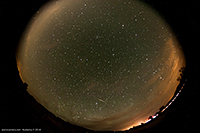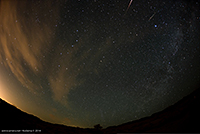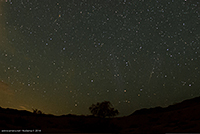
Sky map of predicted radiant position.

Ultra-wide fisheye image including one of two bright meteors of the evening (view looking east).

All-night composite image of meteors (view looking north).

Enlargement from the all-night composite image of meteors (view looking north).

Meteor trail time-lapse image.
The much-hyped Camelopardalid meteor shower was A BUST! The concensus on the internet was that there were far fewer meteors than expected. There were clearly even fewer meteors than we see during an annual meteor shower such as the Perseid, Leonid, or Geminid meteor showers, though we did see two nice slow, bright meteors.
To add insult to injury, clouds at my observatory caused us to decide to travel another ~100 miles to Joshua Tree National Park (JTNP), but we ended up sandwiched between the coastal clouds and thunderstorms encroaching from the east. After waiting until sunset inside the park, we decided that the situation did not look like it would improve, so we moved outside the south end of the park, just north of Interstate 10.
As it turned out, it was a decent spot under the circumstances. Since we were looking north, away from the I10 freeway, the highway traffic didn't really bother us, and conditions on the ground were warm all night, but with low humidity. Clouds kept coming and going, mostly in the southwest in the direction of the worst light pollution (Palm Springs), but for the expected peak of the shower, we had a large hole in the clouds for viewing.
The bottom line for the night:
- Planes: Over a hundred
- Satellites: Dozens
- Cars entering/exiting Joshua Tree Nat. Park: Dozens*
- Camelopardalid meteors visually spotted: 6-10
- Sporadic meteors visually spotted: 6-10
- Camelopardalid meteors photographed: 4-6
... We didn't come away empty-handed, but it was a very disappointing showing for so much media-hype.
*Cars were coming and going all night! There were about an equal number of perhaps late arrivals anticipating a good show, and disappointed departures...
Technical Details -
Camera: Nikon D600 @ ISO 3200,
Lens: Sigma 15mm, f/2.8,
Exposure: 30 sec.
Camera: Nikon D700 @ ISO 3200,
Lens: Rokinon 8mm, f/4,
Exposure: 30 sec.
Location: Outside south end of Joshua Tree National Park

